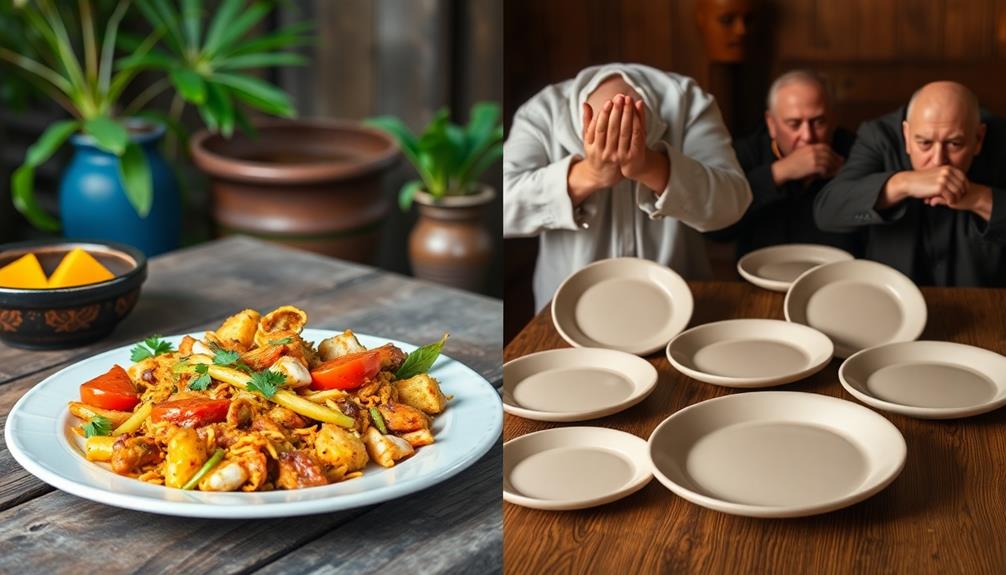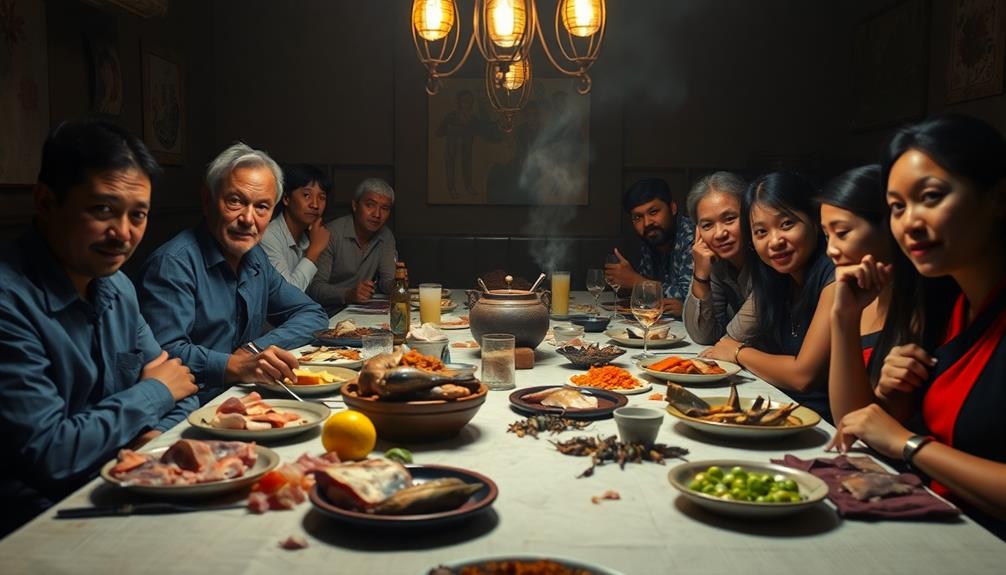Certain foods are considered taboo for many reasons! Here's a fun breakdown:
- Religious beliefs: Some groups avoid pork or beef due to sacred views.
- Cultural norms: In some places, eating insects might be normal, while in others, it's not!
- Health concerns: Pregnant women in certain cultures skip specific foods for safety.
- Ethical choices: Many people embrace plant-based diets to protect animals.
These unique choices help shape traditions and bring communities together. Curious to learn more about how these taboos affect different cultures? You're in for an exciting journey ahead!
Key Takeaways
- Food taboos arise from a mix of religious, cultural, environmental, ethical, and health factors that shape dietary choices across societies.
- Religious doctrines, such as kosher and halal laws, dictate specific food prohibitions based on beliefs about cleanliness and sacredness.
- Cultural norms influence perceptions of acceptable foods, leading to practices like avoiding dog meat in Western cultures.
- Ethical considerations, including animal rights and sustainability, drive modern dietary changes, encouraging plant-based diets and local sourcing.
- Local laws and traditions can enforce taboos, such as beef avoidance in Hindu communities and turtle meat bans on Buzios Island for conservation.
Causes of Food Taboos

Food taboos often arise from a mix of religious, cultural, environmental, ethical, and health factors. These food prohibitions shape our diets and reflect our identities.
For instance, religious doctrines guide many people in their food choices. In Judaism and Islam, pork is considered impure, so it's avoided. Cultural norms also play a big part. In Western societies, many folks steer clear of dog meat, showing their values and feelings about certain animals.
Additionally, culinary traditions, like those in Brazilian cuisine, showcase how diverse influences, such as African Heritage, can shape what's deemed acceptable or taboo.
You'll find that health concerns can create dietary rules, too! Some traditional practices suggest avoiding certain fish during pregnancy due to perceived risks. Plus, ethical movements encourage us to protect endangered species and support sustainable seafood. This means some people choose not to eat these foods to help our planet.
Local laws can even enforce these taboos. In many Indian states, for instance, beef consumption is banned because cows are held in high regard in Hindu culture.
All these factors blend together, creating a rich tapestry of food taboos that reflect who we're and where we come from. So, the next time you encounter a food taboo, remember the fascinating reasons behind it!
Religious Dietary Restrictions

Many cultures around the world have specific religious dietary restrictions that shape their eating habits. These rules often help people connect with their beliefs while deciding what to eat. For example, Jews follow kosher laws, which prohibit the consumption of pork and shellfish, and they can't mix meat and dairy.
Muslims have halal guidelines, where pork is a big no-no, and they guarantee animals are slaughtered in a sacred way. In Indian cuisine, many dishes cater to these dietary restrictions, offering a variety of vegetarian options like Mushroom Masala that are both flavorful and compliant with religious practices.
Here are a few more interesting examples:
- Jainism insists on strict vegetarianism, meaning no animal consumption at all.
- Hinduism often sees cows as sacred, so beef is generally avoided.
- During Lent, many Christians choose to give up meat or specific foods.
- Blood spots in eggs make them taboo for both Jews and Muslims, while blood-free eggs are perfectly fine!
These dietary restrictions can make meals special, as they remind you of your faith and traditions.
Cultural Perspectives on Food

Cultural perspectives on food reveal fascinating differences that shape what we consider acceptable to eat. Food taboos can be surprising! In the United States, you might think of insects and rats as unappetizing, but many cultures enjoy these delicacies, such as the rich flavors of Muamba De Galinha in Angola, where certain ingredients are celebrated.
Religious dietary laws also play a big role. For example, in Jewish and Muslim cultures, pork is off-limits due to faith. This reflects how cultural beliefs guide the consumption of certain foods.
Pregnant women in Upper Manya Krobo, Ghana, aren't allowed to eat snails and rats because of health concerns. Similarly, when social changes happen, like newly married men in Papua New Guinea, they may only eat smoked meat to mark their new identity.
In some tribes, like the Orang Asli in West Malaysia, a medicine man decides which foods are acceptable during illness. These dietary practices show how deeply culture influences what we eat.
Understanding these perspectives makes food more exciting! It's a reminder of how diverse our world is and how food connects us to our heritage and community, adding a flavorful twist to our meals. Not only do different cuisines tell stories of cultural tradition, but they also evoke powerful emotions and memories. The psychology behind comfort food further explains why certain dishes bring us feelings of warmth and nostalgia, often transporting us back to cherished moments with loved ones. Food, in this sense, becomes more than just sustenance; it plays a profound role in shaping our experiences and emotional well-being.
Modern Ethical Influences

As our understanding of food expands, modern ethical influences are reshaping what we eat and how we approach our diets. You'll notice that many people are making dietary changes based on values like animal rights and sustainability. This means some foods are becoming taboos, especially those linked to cruel practices or harmful environmental impacts.
For instance, many are turning to farm-to-table cooking to enjoy fresh, local ingredients that support ethical farming practices. Here are some exciting trends to explore:
- Veganism: Choosing plant-based foods that support animal rights.
- Locally sourced foods: Embracing the 100-Mile Diet to reduce transportation impacts.
- Organic certification: Opting for foods free from synthetic chemicals and GMOs.
- Conservation efforts: Supporting practices that protect endangered species.
These movements encourage ethical consumerism, where you think about how your food choices affect the world. Many folks are now avoiding factory-farmed meats and rejecting shark finning, promoting a kinder approach to eating.
Case Studies of Prohibitions

Food taboos often reveal deep-seated beliefs and values within communities. For instance, in Hinduism, the consumption of beef is taboo because cows hold a sacred status. Many Indian states even have laws to protect these gentle creatures.
Similarly, Jewish dietary laws and the Quran inform followers that they shouldn't eat pork, as pigs are seen as unclean animals.
In Japan, certain ingredients like the guts of fish or certain types of offal can be considered taboo due to cultural preferences, while delicacies like ankimo (monkfish liver pâté) showcase the complexity and luxury of their cuisine.
In other cultures, taboos can be quite interesting! The Navajo people have fish consumption taboos based on cultural beliefs and health reasons, showing how food choices can connect deeply to identity.
In mid-west Nigeria, you might be surprised to learn that coconut milk is avoided in children's diets. Why? Some believe it could impair their intelligence, revealing how cultural misconceptions shape food taboos.
On Brazil's Buzios Island, turtle meat is off the menu for conservation reasons. Protecting endangered green sea turtles reflects a blend of cultural practices and environmental care.
These case studies of prohibitions highlight how our choices about what we eat often connect to our beliefs, traditions, and the world around us!
Frequently Asked Questions
Why Are Certain Things Taboo?
Certain things are taboo because of cultural norms, societal beliefs, or historical practices. These prohibitions help maintain group identity and cohesion, guiding your behavior and choices while influencing how you interact with others.
What Are the Food Taboos and Examples?
Food taboos vary greatly across cultures. For example, you might avoid pork in some religions, while others shun insects. In Ghana, pregnant women can't eat snails, reflecting specific health beliefs tied to cultural practices.
What Are 5 Examples of Taboos?
Steering food choices can feel like walking a tightrope. You'll find pork, beef, horse meat, shellfish, and turtle meat are examples of taboos, each steeped in cultural beliefs and practices that shape our dining experiences.
What Are American Food Taboos?
In America, you'll find taboos against eating insects, rodents, horse meat, and dog meat. Many also avoid raw fish during pregnancy, reflecting cultural beliefs and health concerns that shape food choices across the country.
Conclusion
In the end, food taboos are like a colorful tapestry, woven from threads of culture, religion, and personal beliefs. They help shape our meals and bring us together as families, celebrating our differences. By understanding why certain foods are off-limits, we can appreciate the rich variety of cuisines around the world. So, let's keep an open mind, share our traditions, and enjoy the feast of flavors that life has to offer!










